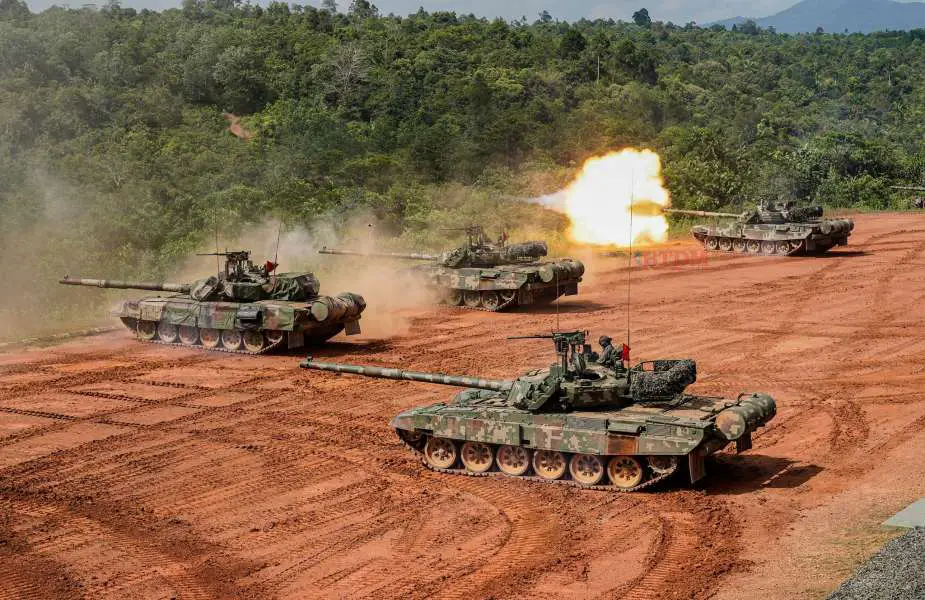Breaking news
Malaysia launches Ambitious Program to extend life of 'Pendekar' PT-91M Tanks.
On March 25, 2024, the Malaysian Ministry of Defense announced the launch of a Life Extension Program (LEP) for its 48 main battle tanks, the "Pendekar" PT-91M. This initiative, unveiled by Defense Minister Datuk Seri Mohamed Khaled Nordin, highlights Malaysia's commitment to maintaining and enhancing its military arsenal.
Follow Army Recognition on Google News at this link

Malaysia 'Pendekar' PT-91M Main Batlle Tank (Picture source: Malaysia MoD)
The LEP, expected to be included in either the 12th or 13th Malaysia Plan (RMK-12 or RMK-13), aims to address several challenges, notably the cessation of spare parts production by the Polish Original Equipment Manufacturer (OEM) Bumar Laberdy. This situation becomes even more critical as the "Pendekar" PT-91M tanks have been tested in recent conflicts, such as the war in Ukraine, demonstrating the need for technological updates and capability improvements.
Acquired by the Malaysian army between 2007 and 2011, the "Pendekar" PT-91M serves as a cornerstone of the country's defense strategy, playing a key role as a major offensive asset. Stationed under the command of the 11th Royal Armour Regiment at the Syed Sirajuddin camp in Gemas, these tanks are a crucial element of Malaysian military deterrence.
Facing potential obsolescence and operational challenges, the Malaysian government has also taken steps to reduce its dependence on the OEM by developing local expertise for parts replacement and maintenance. This move towards increased autonomy in managing its military equipment marks a significant step, reflecting a desire to ensure greater resilience and flexibility in defense operations.
A maintenance and spare parts supply contract is currently in place, ensuring the operational readiness of the tanks until September 2025. Additionally, a joint study is underway to identify critical issues related to transmission, electronic components, and fire control systems, with results expected by March 2024.
However, it is important to note that the Malaysian PT-91 has undergone numerous modifications compared to the Polish version used by Ukrainians against Russian forces. The first PT-91 was built in the winter of 2005 and underwent rigorous testing at Polish ranges, with participation from representatives of the Malaysian army overseeing contract fulfillment. After minor modifications resulting from test analyses, the tank was transported to Malaysia. The PT-91M's public debut occurred on August 31, 2005, in Kuala Lumpur, during Malaysia's grand Independence Day parade.
Moreover, the final version of the PT-91M is powered by a new propulsion group developed by PZL Wola in collaboration with the German company Renk, consisting of an S1000R engine with 1000 horsepower and an SESM Renk ESM350M driving system. The tank is also equipped with the 2A46MS cannon from the Slovak company Konstrukta Defense, an electronic stabilization system from EADS, and new mechanisms for cannon elevation and turret rotation. The front armor plates and turret configuration have also been modified.
Furthermore, the PT-91M features Sagem Savan 12 fire control systems with a VIGY-15 panoramic surveillance device for the commander. The armor has been strengthened for enhanced protection. The tank incorporates the SSP-1 Obra 3 universal self-defense system from the Industrial Optics Center, working with two sets of 81 mm 902A smoke grenade launchers from ZM DEZAMET. The armament includes a 7.62 mm machine gun from the Belgian company FN Herstal, as well as a 12.7 mm M2HB-QCB heavy machine gun operated by the commander and mounted on the turret.
Significant construction changes have also been made to the tank, particularly in the driver's section, which has been considerably modified. For the first time in the T-72 tank family, a steering wheel was installed in place of a friction link. The tank is also equipped with an air conditioning system, a modern protection system against weapons of mass destruction and pollution detection. A battlefield control system, as well as LNS navigation and GPS systems, have been integrated.
The Defense Ministry's commitment to this life extension program underscores a proactive defense strategy, aimed at ensuring that Malaysia remains well-equipped to face current and future threats. As the region faces increasing tensions and complex security challenges, the modernization of Malaysia's military capabilities is more relevant than ever, underscoring its role as a key player in peace and stability in Southeast Asia.





























